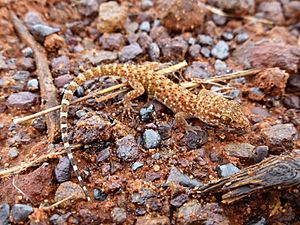Heteronotia binoei facts for kids
- For the genus called prickly geckos, see Heteronotia
- For the species called Bynoe's prickly gecko, see Heteronotia planiceps
Quick facts for kids Heteronotia binoei |
|
|---|---|
 |
|
| Conservation status | |
| Scientific classification | |
| Genus: |
Heteronotia
|
| Species: |
binoei
|
The Heteronotia binoei, also called the prickly gecko or Bynoe's gecko, is a type of lizard in the Gekkonidae family. This gecko lives only in Australia. It is one of Australia's most common geckos and can live in many different places. You can find it across most of the country. It has even started living in cities like Perth, Western Australia where it wasn't before.
This gecko is usually dark brown or reddish brown. Its color depends on the ground it lives on. It has light bands with dark edges along its back. The Bynoe's gecko is special because it can reproduce without a male. This is called parthenogenesis.
Contents
Why is it called Bynoe's Gecko?
The Bynoe's gecko is named after Benjamin Bynoe (1804-1865). He was a British naturalist and a surgeon. Benjamin Bynoe sailed on the ship HMS Beagle. This was the same ship that Charles Darwin was on!
What Does it Look Like?
The Bynoe's gecko is a thin lizard with a long tail. It can grow to be about 11 to 12 centimeters (around 4 to 5 inches) long. Its body is covered with small scales. These scales look rough but feel soft when you touch them.
This gecko has slim toes that end with strong claws. But unlike many other geckos, it does not have sticky pads on its toes. It has a large head and big eyes. It does not have eyelids. Instead, its eyes are covered with clear scales. To keep its eyes clean, the gecko wipes dirt off them with its tongue.
The gecko's back has small, spine-like ridges. These ridges run all the way down its back. This is why it is sometimes called the "prickly gecko." Their colors can be yellow, cream, beige, black, and white. Most geckos have at least two of these colors. They might have stripes, speckles, spots, or blotches on their bodies.
It usually has a dark line near its eyes and another dark line along its snout. Its lips are whitish and often have light brown spots. Like many geckos, the Bynoe's gecko can make many different sounds. It has good vocal cords for this.
Where Does it Live?
The Bynoe's gecko is found in all mainland states of Australia. It does not live in the Australian Capital Territory. It is also not found in the very wet parts of the southeast and southwest. This gecko also lives on many islands off Australia's west coast. There are large groups of them on Barrow Island.
What is its Habitat Like?
The Bynoe's gecko lives in many different places across Australia. It is most often found in woodlands and grasslands. It also likes open, dry areas and places that have been changed by people. You can also find it in tropical rainforests, central deserts, and sandy dunes near the coast.
This gecko lives on the ground. It finds shelter under many things. These include leaves, logs, stumps, stones, termite mounds, and loose bark at the bottom of trees. It also hides in animal burrows. It has even been found sheltering under things made by humans. The Bynoe's gecko is often the most common reptile in many dry areas of Australia.
Reproduction and Life Cycle
In Australia, the Bynoe's gecko is ready to breed between July and September. They become adults and can reproduce when they are 1 to 3 years old. Female geckos lay two eggs between September and January.
When the eggs are first laid, they are soft. But they become hard and brittle when they touch the air. These eggs are usually laid under rocks, inside animal burrows, or inside logs. Each female only lays one set of eggs per year. On Barrow Island, female geckos reproduce by parthenogenesis. This means the eggs develop and grow without needing a male gecko to fertilize them.
What Does it Eat?
The Bynoe's gecko is mostly active at night. It leaves its hiding spot and hunts for different invertebrates. These include moths and grasshoppers. It hunts among fallen leaves or in open spaces. Sometimes, it will climb trees or rocks to find food.
Who are its Predators?
Like many other geckos, the Bynoe's gecko has many predators. It can run away very fast when it feels threatened. But it can still be attacked by other animals. These include larger lizards.


